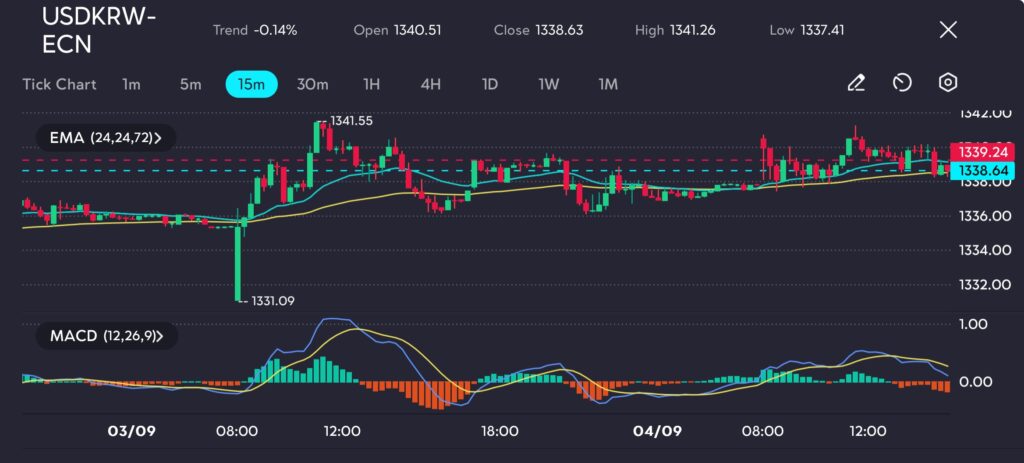Key points:
- The forex reserves of South Korea reached a high of $415.9 billion, up from $413.5 billion in July.
- Securities holdings grew to $369.4 billion, while deposits fell significantly to $22 billion.
- USDKRW remained stable as rising reserves provided confidence in the ability of South Korea to support the currency.
USDKRW remain as of Wednesday morning, trading around 1,320 won per dollar, despite a significant change in the foreign exchange reserves of South Korea.
The foreign exchange reserves show a rise in August 2024, hitting $415.9 billion, up from $413.5 billion in the prior month. This increase marks the highest level since March 2024 and was mainly driven by an increase in securities holdings, which rose to $369.4 billion from $367 billion in July.

Picture: USDKRW remains stable despite significant changes in the forex reserves of South Korea, as observed on the VT Markets app.
The USD/KRW pair saw a slight decline of 0.14% during the session, closing at 1,338.63, down from its daily high of 1,341.26. We see on the charts that the currency pair fluctuated within a tight range, which may very well be reflective of the current cautious sentiment. We also see that the pair found support near 1,337.41, while resistance remains just above 1,341.55, suggesting that the market may continue to trade within these levels in the short term.
From a technical standpoint, the 15-minute chart highlights a mixed trend. The moving averages (EMA 24, 72) appear to be converging, indicating that momentum is weakening. Additionally, the MACD shows that bullish momentum is losing steam, with the histogram shrinking, suggesting that the price could enter a consolidation phase.
Special Drawing Rights (SDRs) also posted a rise, moving to $15.2 billion, reflecting confidence in South Korea’s monetary policy. However, deposits dropped sharply, from $122.4 billion to $22 billion, potentially signaling a reallocation towards more stable or liquid assets such as government bonds.
Stronger liquidity in the South Korean won
This stability can be attributed to the rise in South Korea’s foreign exchange reserves, which provides the Bank of Korea with ample liquidity to defend the currency should any pressures arise. By increasing its securities holdings, the country has strengthened its ability to cushion against external economic shocks, especially if global economic uncertainties intensify.
Despite a fall in deposits, the Korean won (KRW) remains well-supported, helped by the confidence that ample reserves give to investors. We believe this indicates that traders expect less volatility in the won in the short term, especially given the central bank’s potential to step in to stabilize the currency if needed. Moreover, the growing U.S. dollar weakness has lent further support to KRW.
However, if market expectations about the Fed’s interest rate cut in September shift, we may see USDKRW fluctuate. Traders will also keep an eye on future Reserve Bank of Korea policies, especially regarding their plans for managing the reserve composition.
Outlook for short term traders
The rise in the South Korean reserves, particularly through securities, enhances the ability of the Bank of Korea to support the currency. This can be reassuring for those who have been concerned about currency volatility in light of global economic uncertainties.
However, if the September rate cut by the U.S. Federal Reserve is more substantial than expected, we could see renewed pressure on the won as global investors seek higher yields in the dollar.
In the short term, traders should monitor USDKRW closely for any deviations from its current trading range, especially with upcoming U.S. inflation data and the Fed’s interest rate decision on the horizon.









